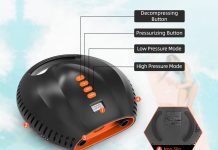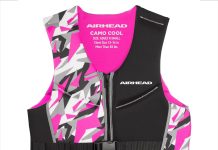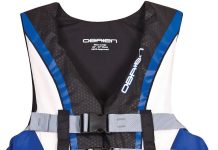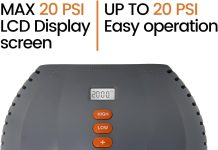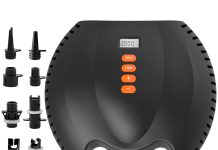In this article, we will provide you with essential tips on how to properly wear and adjust a Stand-Up Paddleboard (SUP) Personal Flotation Device (PFD). Exploring the waterways on your SUP can be incredibly enjoyable, but safety should always remain a top priority. A properly fitted PFD not only ensures your safety but also allows you to fully enjoy your time on the water without any distractions or discomfort. So, whether you’re a beginner or an experienced paddler, read on to discover our expert advice on wearing and adjusting your SUP PFD for a worry-free and enjoyable paddleboarding experience.
Choosing the Right SUP PFD
Choosing the right SUP (Stand-Up Paddleboard) PFD (Personal Flotation Device) is crucial for ensuring your safety on the water. There are different types of PFDs available, each designed for specific purposes. Understanding these PFD types will help you make an informed decision.
Understanding PFD Types
PFDs are categorized into several types based on their buoyancy and intended use. Type I PFDs, also known as offshore life jackets, provide the highest level of buoyancy and are suitable for open water where rescue may take longer. Type II PFDs, or near-shore buoyant vests, are designed for calmer waters and provide less buoyancy than Type I PFDs. Type III PFDs, often called flotation aids, are commonly used for watersports like paddleboarding. Type IV PFDs are throwable devices like ring buoys or cushions, while Type V represents specialized PFDs for specific activities.
Certifications and Regulations
When choosing a SUP PFD, ensure that it complies with the relevant certifications and regulations. Look for the label indicating that the PFD meets the standards set by the United States Coast Guard (USCG). The USCG requires PFDs to be in serviceable condition, legibly marked, and of proper size for the intended wearer. Additionally, some states and municipalities may have specific regulations regarding PFD use, so it’s essential to familiarize yourself with the local rules before hitting the water.
Proper Sizing and Fit
Having a properly-sized and well-fitted SUP PFD is essential for your safety and comfort. Various sizes are available to accommodate different body types and weights. To determine the right size, measure your chest circumference at its widest point and refer to the manufacturer’s sizing chart. When trying on a PFD, ensure a snug fit without feeling too tight or restrictive. Adjust the straps according to your body shape for a secure and comfortable fit.
Inspecting Your SUP PFD
Before heading out on the water, it’s crucial to inspect your SUP PFD to ensure its integrity and functionality. Regular inspections will help identify any damage or wear that could compromise its effectiveness in an emergency.
Checking for Damage or Wear
Inspect the SUP PFD for signs of damage or wear. Look for any visible tears, fraying, or disintegration of materials. Check the seams, stitching, and straps for any signs of weakness. If you find any damage, it’s important to immediately replace or repair the PFD to maintain its reliability.
Testing the Buoyancy
Ensure the PFD’s buoyancy is intact by conducting a simple test. Before donning the PFD, hold it upright in the water and ensure it remains buoyant. If it sinks or doesn’t provide enough buoyancy, it may be time for a replacement. Remember, a PFD is only effective if it keeps you afloat.
Verifying the Buckles and Straps
Check all the buckles, zippers, and straps on the PFD for proper functionality. Ensure that they open and close smoothly without any resistance or signs of damage. Adjust the straps to verify that they hold securely and that they can be easily tightened and loosened as needed.
Preparing for Wearing a SUP PFD
Before donning your SUP PFD, take a few steps to ensure proper preparation. These preparations will enhance your overall experience and safety on the water.
Adjusting Clothing Layers
Consider the weather and water temperature when choosing your clothing layers. Dressing appropriately will help you stay comfortable and regulate your body temperature. If the weather is colder, consider wearing a wetsuit or a paddle jacket for extra insulation. In warmer conditions, a lightweight and breathable shirt will suffice. Remember, your clothing layers should not interfere with the proper fit of your PFD.
Securing Loose Items
Make sure to secure any loose items or accessories you’re carrying with you. Loose gear such as hats, sunglasses, or water bottles can become a distraction or even fall into the water, potentially creating a hazardous situation. Use secure attachment points or storage compartments on your paddleboard to keep your items safe.
Ensuring Easy Access to Pockets
Many SUP PFDs come equipped with pockets for storing small essentials or safety equipment. Ensure that these pockets are easily accessible and properly secured. It’s helpful to organize your items beforehand so that you can quickly and easily retrieve them when needed.
Wearing Your SUP PFD
Wearing your SUP PFD correctly is crucial to ensure its effectiveness in case of an emergency. Follow these steps to properly position and secure your PFD for optimal safety.
Positioning the PFD on Your Body
Place the SUP PFD on your torso, ensuring that it covers your chest and upper back. The PFD should fit snugly but not be uncomfortably tight. Adjust the PFD’s position so that it sits high on your chest and does not obstruct your movement or restrict your breathing.
Fastening the Buckles and Zippers
Starting from the bottom, fasten the buckles or zip up the front closure of your SUP PFD. Ensure that all buckles and zippers are securely closed and properly aligned. Double-check to make sure there are no twists or tangles in the straps.
Confirming the Correct Fit
Once fastened, take a moment to ensure that the SUP PFD fits correctly. Check that the PFD does not ride up or shift excessively when you move your arms or bend forwards. It should remain securely in place without restricting your mobility or causing discomfort.
Adjusting Your SUP PFD
Even with a proper initial fit, certain adjustments may be necessary to ensure that your SUP PFD remains secure and comfortable throughout your paddleboarding session. Follow these guidelines for making necessary adjustments.
Loosening or Tightening Straps
Check the straps on your SUP PFD to ensure that they provide a snug fit without being overly tight or restrictive. If the straps are too loose, tighten them to achieve a secure fit. Conversely, if they feel too tight, loosen them slightly to alleviate any discomfort.
Checking for Mobility and Comfort
Try moving your arms and upper body while wearing the PFD. Ensure that the SUP PFD allows for full range of motion without hindering your movements. If you experience any restrictions or discomfort, reposition the PFD and adjust the straps until you achieve a comfortable fit.
Avoiding Overly Loose or Snug Fits
While it’s important to have a snug-fitting SUP PFD, avoid making it excessively tight. Tightness can restrict blood circulation and breathing. Likewise, an excessively loose PFD may not provide proper buoyancy or stay securely in place during water activities. Finding the right balance is key to a safe and comfortable paddleboarding experience.
Proper Placement of SUP PFD Straps
Getting the strap placements right can further enhance the effectiveness and comfort of your SUP PFD. Pay attention to the following adjustments.
Shoulder Strap Adjustments
The shoulder straps should sit comfortably on your shoulders without placing excessive pressure or slipping off. Adjust the length as necessary to ensure a secure fit that allows for freedom of movement.
Chest Strap Adjustments
The chest strap should sit across your chest and should not rub or cause discomfort. Adjust its position or length to achieve a snug but comfortable fit. The chest strap plays a significant role in keeping the SUP PFD in place during water activities.
Waist Strap Adjustments
The waist strap helps secure the SUP PFD firmly around your body. It should fit snugly around your waist without causing any discomfort or restricting your movement. Adjust the waist strap until you achieve the ideal balance of security and comfort.
Additional Tips for Wearing and Adjusting
Here are a few more useful tips to ensure you’re wearing and adjusting your SUP PFD effectively:
Practicing In-Water Adjustments
Take the time to practice adjusting your SUP PFD while in the water. This will help you become familiar with the process and make any necessary adjustments more efficiently should the need arise during an actual paddleboarding session.
Ensuring Visibility with Reflective Panels
For added safety, consider choosing a SUP PFD with reflective panels. These panels enhance visibility, making it easier for others to spot you on the water, especially in low light conditions.
Avoiding Common Mistakes
Avoid common mistakes such as wearing the SUP PFD loosely, not fastening all the buckles and zippers, or positioning the PFD too low on your torso. Following the proper wearing and adjustment techniques will ensure your SUP PFD functions optimally.
Maintenance and Care for SUP PFDs
To keep your SUP PFD in top condition and prolong its lifespan, it’s essential to follow proper maintenance and care practices.
Cleaning and Drying
Rinse your SUP PFD with fresh water after each use to remove any salt or debris and extend its durability. Occasionally, use a mild soap or cleaner recommended by the manufacturer to remove any stubborn stains or odors. After cleaning, allow your PFD to fully dry in a well-ventilated area before storing it.
Inspecting for Wear and Tear
Regularly inspect your SUP PFD for signs of wear and tear. Look for any loose threads, faded colors, or weakened materials. Check the buckles, zippers, and straps for signs of damage or stiffness. If you notice any issues, consult the manufacturer’s guidelines, and consider repairing or replacing your PFD as necessary.
Storage Considerations
Proper storage is crucial for maintaining the integrity of your SUP PFD. Store it in a cool, dry place away from direct sunlight. Avoid storing your PFD in compressed or folded positions, as this can damage the foam buoyancy material. Hanging your PFD or laying it flat in a storage container is a better option.
Conclusion
Wearing and adjusting your SUP PFD properly is vital for your safety and enjoyment while paddleboarding. Take the time to understand the different types of PFDs and choose the right one for your needs. Ensure that your PFD is in good working condition by conducting regular inspections. Properly prepare for wearing a PFD by adjusting clothing layers and securing loose items. When wearing your SUP PFD, position it correctly, fasten all the buckles and zippers, and confirm the correct fit. Regularly make adjustments to ensure a secure and comfortable fit. Don’t forget to properly place and adjust the straps for optimal performance. Finally, follow maintenance and care practices to prolong the lifespan of your SUP PFD. By following these guidelines, you can confidently and safely enjoy your paddleboarding adventures.


